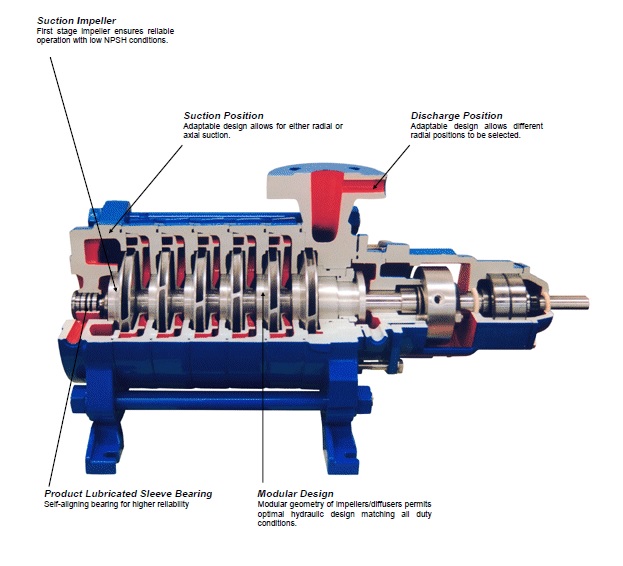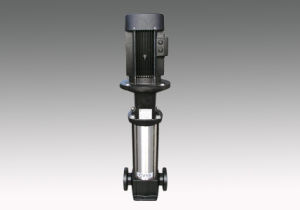The short answer to “what is a multistage centrifugal pump used for?” is that it depends on the type of pump, but many applications can benefit from these pumps. Multi-stage centrifugal pumps are popular pumps in different applications. Their capability to provide a flexible range of flow and head for engineers, along with their high energy efficiency, makes them an excellent choice for many purposes.
What is a Multi-Stage Centrifugal Pump
Multistage centrifugal pumps are manufactured with two or more impellers. The rotors can be installed on the same or different shafts depending on the configuration. If high pressures of outflow are required, the rotors can also be joined in series. However, in the case of high capacity requirements, they are often connected in parallel.
Multistage centrifugal pumps are applied to make high pressure on the shaft in the same housing, which is more economical than a pump with a single impeller. As part of the pump structure, the channels within the pump housing work by directing an impeller discharge to suck the other.
Water enters the pump and passes through an assembly of rotors in series, from left to right. From there, water flows from the spiral around the spiral of one rotor to make suction for the next rotor. Usually, these types of pumps are single-stage pumps. A multi-stage centrifugal pump has a much better performance.
In some cases of multi-stage centrifugal pumps, axial pressure forces can be balanced by balancing blades installed at the rear of the impellers. The angular ball bearing on the drive side and the heavy-duty ball bearing on the drive side are used to absorb the remaining forces.
Multi-stage centrifugal pumps come with two outer bearings, a seal pressure-balancing line that discharges pressure from the seal section on the discharge side back to the suction side. Due to this unique design, more economical sealing arrangements can be used, even when the pump works under high pressures.
The pumps are offered in different sizes based on the application and volume. Smaller multi-stage centrifugal pumps suffice for heating plants, fire-fighting operations, water pipelines, irrigation, agriculture, boiler feed, autoclaves, hydrocarbons, and carrying lightly soiled but also clean liquids.

Working Principle of Multi-Stage Centrifugal Pumps
The more the number of stages of the pump, the greater the outlet discharge pressure. These pumps have the outstanding ability to produce higher pressures after adding in each stage, but the range of the flow always remains constant at a certain speed. Each stage comprises a rotor, a diffuser, and directional return blades (often combined with a diffuser), all in one and the same stage housing.
The pressure head of a single-stage centrifugal pump is considerably adjusted by the impeller type and the circumferential speed. If the rotational speed must be constant due to operating conditions, a larger impeller diameter leads to very low specific speeds and uneconomical efficiencies. So, installing multiple stages in series can be an economical choice to increase the head. If the number of stages is changed at fixed dimensions and speeds, the flow rate of the multistage pump does not alter, but the power input and head increase proportionally to the number of the stages.
In multi-stage pumps, the fluid flows through multiple impellers installed in series. The fluid enters the first chamber (or stage) under pressure in the suction line and drains at a certain elevated pressure. After leaving the first stage, the fluid enters the second stage, in which the pressure increases again.
Using multi-stage pumps is an economical way to reach higher pressure ranges in the pump series selection diagrams. However, one drawback in using too many stages is the increased sensitivity of the rotor to external or natural vibrations.
An example of a pump with multi-stage casings of the same type arranged in tandem is the ring-section pump. This pump type is usually applied in power stations, such as a boiler feedwater pump, and for industrial purposes that require high pressures.
The distinct stages of a multi-stage centrifugal pump do not necessarily have to be fitted in tandem. The balancing of axial force can be improved by putting the stages back to back in pairs or groups. A common example is the pipeline pump.
The inlet housing with the axial or radial inlet nozzle is located before the first stage, regardless of the number of stages, and the last stage is positioned in the outlet housing, including the balancing tools and the shaft seal. Only the pump shaft, tie rods, and base plate should be arranged to accommodate the needed number of steps.
Types of Multi-Stage Centrifugal Pumps
There are two types of multi-stage pumps: those with horizontal shafts and those with vertical shafts.
Horizontal Multi-Stage Centrifugal Pumps
Horizontal pumps are the most commonly used multi-stage centrifugal pump consistently for the applications mentioned above. These types of pumps work by pressurizing the fluids as they move horizontally through multiple impellers. Horizontal pumps are typically capable of working with higher flow rates than vertical counterparts (with the exception of vertical turbine pumps). You can recognize horizontal multi-stage centrifugal pumps by the segmented casing.
However, the use of horizontal multi-stage pumps has some minor disadvantages compared to vertical pumps. Horizontal pumps may need more maintenance and also a skilled set of hands to run them.
Depending on their characteristics and the purposes for which they are used, horizontal multi-stage pumps can be very expensive, especially when compared to vertical models.

Applications
The horizontal multistage centrifugal pumps are best for applications including:
- Reverse osmosis (to remove impurities from water)
- Boiler feed water (to pump the water into a steam boiler)
- Shower
- Cogeneration
- Water pressure boosting
- Spray
- High-pressure Cleaning (to create a strong stream of water for cleaning an object)
- Snowmaking (to pressurize the water to make snow for sports and resorts applications)
- Mine dewatering
- Condensate
Vertical Multi-Stage Centrifugal Pumps
Vertical multi-stage pumps are not as applicable as horizontal pumps because their purposes are more restricted. Vertical multi-stage pumps have a vertical shaft with impellers stacked above each other.
The clearances in this type of multistage pumps are very smaller than their horizontal counterparts, which makes them ideal choices for clean-water applications. With their clean and compact design, these pumps are excellent for places with not much space. They can transfer high-pressure liquid with a combination of a single pump body and motor.
Multistage pumps offer many significant advantages, such as energy savings and their ability to work in a wide range of flow rates and head uses.
However, a significant drawback of vertical pumps is that they cannot withstand debris or solids and are also more susceptible to deadheading.
Deadheading occurs when you prevent a pump from discharging by shutting off a valve. This causes the water to constantly churn inside the pump and ultimately turns to water vapor. Deadheading can seriously damage the centrifugal pumps.

Applications
The following applications are best for vertical multi-stage centrifugal pumps:
- Boiler feedwater
- High-pressure shower systems
- Desuperheater feed
Single-Stage Centrifugal Pumps vs. Multi-Stage Centrifugal Pumps
Centrifugal pumps are subdivided into single or multi-stage pumps. The important point to note is which one should be chosen, which ultimately goes back to their working principle and the application. In the following, we will discuss the difference between these two types.
The main difference between single and multi-stage centrifugal pumps is their impellers and how they affect the performance. A single-stage pump has one rotating impeller installed around the shaft, while multi-stage pumps have two or more impellers. This feature has some implications for performance, such as pressure capability and efficiency.
Pressure Capability
The multiple impellers in a multi-stage centrifugal pump are installed on the same shaft and essentially serve as separate pumps. This means that as the flow goes from one stage to another, the head rises almost by the same amount. So, the design of a multi-stage pump has very higher pressure capabilities than a single-stage pump.
Multistage centrifugal pumps are usually selected as the pressure requirements exceed the ability of a single-stage pump. For example, the fluid may have to be transported over a long distance with significant friction loss, which in most cases is achieved through multiple impellers. A common example is the water supply on top of tall buildings or towers. On the other hand, single-stage centrifugal pumps are better solutions for higher flow and lower pressure installations.
Efficiency
Multi-stage pumps rely on multiple impellers to give the energy into the fluid. The diameter of each impeller can be smaller than in a simple impeller. Also, multi-stages can work with smaller clearances between the impeller and volute. It means that each impeller works close to its best hydraulic efficiency. As a result, multi-stage centrifugal pumps can better operate with a smaller motor size and applying less energy.




Dear Sir
I am Ajay Mittal prop. of Pumpco India
We want your products dealership please send your completely catalog and contact no
Centrifugal pumps need to be multi-staged where they are required to meet high pressure
delivery requirements, which is quite an expensive proposition. What method would you resort
to in order to reduce the number of stages in your pump design?
We appreciate you taking the time to check out our page. Asking one of our specialists will help you get your problem fixed.
I find the article very informative on Centrifugal Pumps